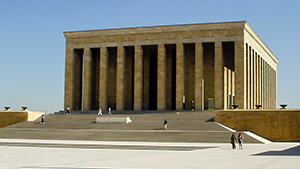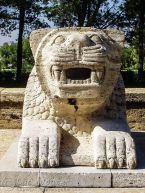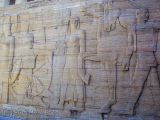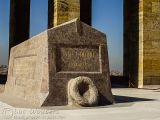The mausoleum of Mustafa Kemal Atatürk, Anıtkabir, or Monumental tomb, as it is called, is one of the highlights of a visit to Ankara. It stands on top of a small hill in a park about 2 km west of Kızılay. Atatürk was the founder of the modern Turkish republic and managed to save the country's territorial integrity in the Greco-Turkish War of Independence. In addition, he was the man who gave back to the Turks their identity and self-esteem. One of his famous quotations is: Ne mutlu Türküm diyene, meaning How happy is he who can say I am Turkish. More info about the life and achievements of Atatürk can be found at the Ataturk memorial web-site.
After the death of Atatürk on November 10, 1938, his remains were transferred to Ankara and placed in a temporary tomb at the Ethnography Museum. The construction of the monumental mausoleum started during the second world war and lasted almost a decade. Its architecture incorporates echoes of the great empires that once ruled Anatolia and captures the true spirit of Anatolia. On November 10, 1953, Ataturk was interred in the mausoleum. The immense marble cenotaph inside the mausoleum is cut from a single piece of stone. The actual tomb of Atatürk is beneath it. The outer walls of the mausoleum are decorated with neo-Hittite reliefs illustrating the war of independence. Opposite Kemal Ataturk's mausoleum is the sarcophagus of İsmet İnönü (1884-1973) who was a close friend and chief of staff during the war of independence. In 1921, he defeated the Greek army at the Battle of İnönü, from which he took his surname. He succeeded Atatürk as head of state after his death in 1938. A relaxed visit to the mausoleum and the museums takes about 2 hours.
https://turkeyphotoguide.com/anitkabir?tmpl=component&print=1&layout=default#sigProId7c8bf86d9a














